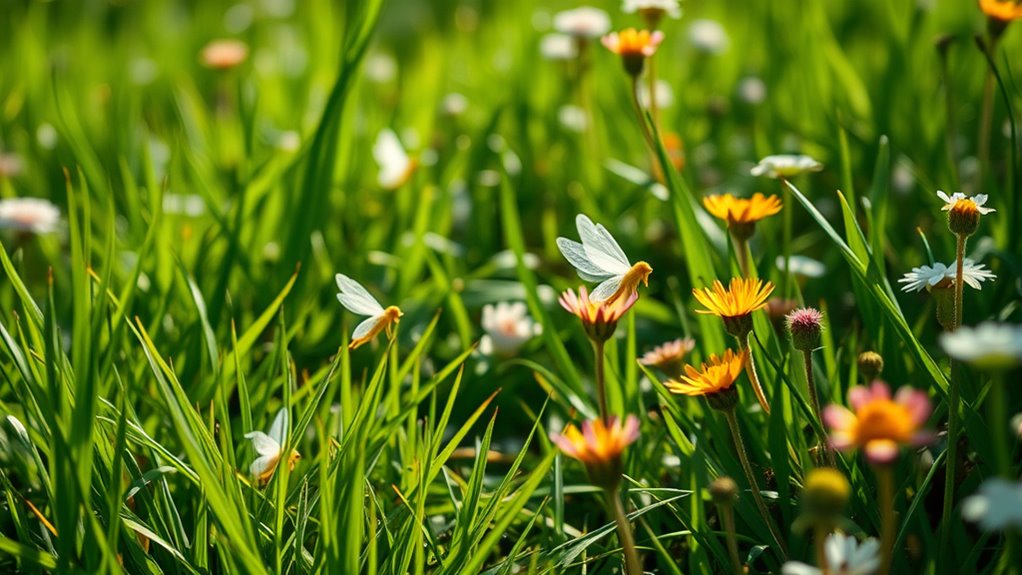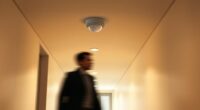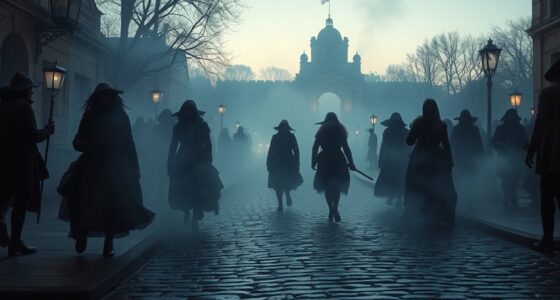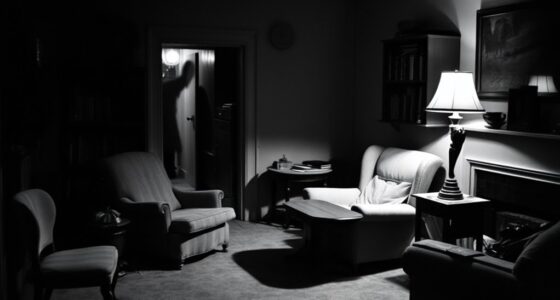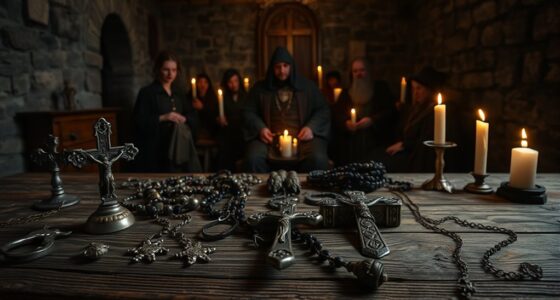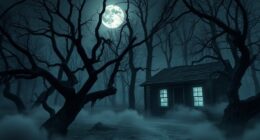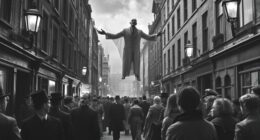The Cottingley Fairies controversy took place in 1917 in England, where two girls claimed to have photographed fairies, sparking worldwide fascination. Their images challenged what people believed about truth and illusion, especially since many saw photography as proof. Skeptics argued they were hoaxes, but notable figures like Sir Arthur Conan Doyle believed in their authenticity. If you continue exploring, you’ll uncover how this event shaped perceptions of photographs and belief.
Key Takeaways
- The Cottingley Fairies photos were taken in 1917 by Elsie Wright and Frances Griffiths in Cottingley, England.
- The images sparked global fascination, with some believing they proved fairies’ existence, while skeptics argued they were hoaxes.
- Sir Arthur Conan Doyle publicly endorsed the photos, boosting their credibility and fueling debate over their authenticity.
- The controversy highlighted the influence of photography on societal beliefs regarding reality, illusion, and the supernatural.
- Key sources include the girls’ original accounts, Doyle’s endorsements, and analyses of the photographs’ technical aspects.
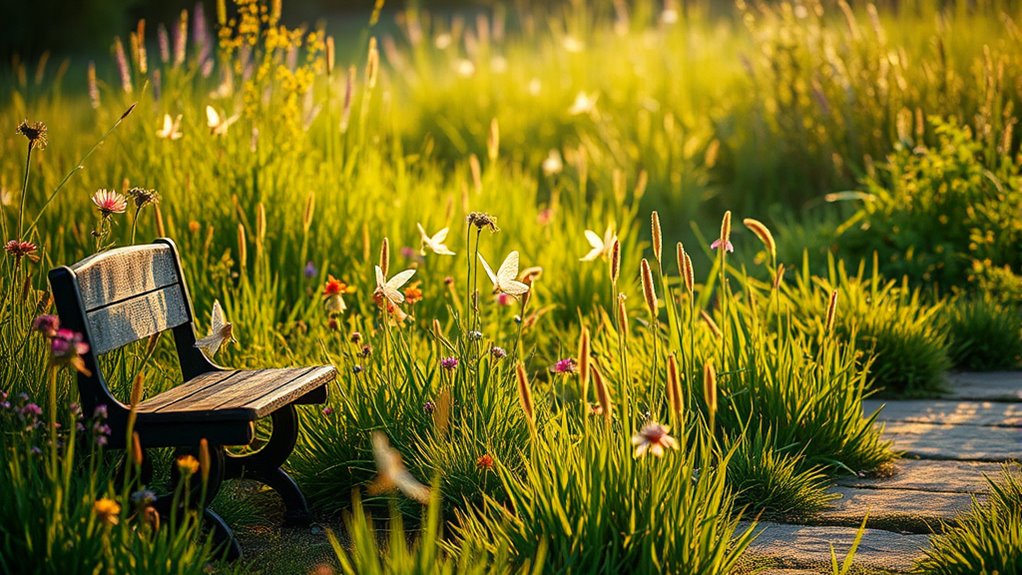
In 1917, two young girls in Cottingley, England, captivated the world by claiming they had photographed fairies dancing in the woods. Their images quickly spread, sparking widespread fascination and debate. At the time, photographic hoaxes weren’t uncommon, but these particular photos resonated deeply because they challenged perceptions of reality and the boundaries of belief. The images seemed to confirm the existence of fairies, fueling both skepticism and wonder. As the photographs gained popularity, they also ignited conversations about the nature of truth, illusion, and the power of photography to influence cultural narratives. The controversy surrounding these images illustrates how a simple act of deception can have a profound cultural impact, shaping beliefs and sparking curiosity across generations.
The girls, Elsie Wright and Frances Griffiths, initially claimed the images were genuine, and their photographs were taken with a camera and some clever tricks. Over time, many skeptics argued they were deliberate hoaxes, crafted with cutouts and painted backgrounds. Despite this, some believed the girls genuinely thought they were capturing real fairies, while others saw the images as playful fabrications. The debate over whether these photographs were authentic or simply photographic hoaxes persisted for decades. Notably, even Sir Arthur Conan Doyle, the creator of Sherlock Holmes, became convinced of their authenticity, lending the images a sense of credibility and elevating their cultural impact. His endorsement helped embed the photographs into popular culture, prompting ongoing fascination and discussion.
The controversy reveals how photographs can influence societal beliefs and perceptions. When the images first appeared, they challenged the scientific and skeptical views of the time, blurring the lines between reality and illusion. The cultural impact extended beyond the initial controversy; the Cottingley Fairies became a symbol of the tension between belief and skepticism, inspiring countless discussions about the nature of truth in visual evidence. The images also highlight how cultural contexts shape public reception—what was dismissed as a simple prank by some became a symbol of innocence and wonder for others. Over time, the photos have been studied and debated, cementing their place in history as an enduring example of how photographic hoaxes can leave a lasting mark on society, influencing beliefs about the supernatural and the power of images.
Furthermore, the case underscores the importance of photo authenticity in shaping public perception and trust in visual evidence.
Frequently Asked Questions
Were the Photographs Ever Conclusively Proven to Be Fake?
You might wonder if the photographs were ever conclusively proven fake. Expert analysis of the photographic authenticity suggests that the images were indeed staged and manipulated, with many skeptics confirming they were hoaxes. Despite ongoing debates, no definitive evidence has emerged to prove the photographs genuine. So, based on available expert assessments, you can reasonably conclude that the Cottingley Fairies photographs were faked.
How Did Sir Arthur Conan Doyle Influence Public Perception of the Photos?
Sir Arthur Conan Doyle greatly influenced public perception of the Cottingley Fairies photos by endorsing their authenticity, blending Victorian folklore and spiritual influence. His fame as a writer lent credibility to the images, making many believe in the supernatural. Doyle’s support encouraged others to see the photos as evidence of spirits and fairies, shaping popular belief and sparking ongoing debates about the intersection of science, spirituality, and folklore.
What Were the Social and Cultural Impacts of the Cottingley Fairy Photographs?
Coincidentally, the Cottingley fairy photographs shaped public belief and left a lasting cultural legacy. You see, they sparked widespread fascination with the supernatural, influencing literature, art, and spiritual movements of the time. The controversy challenged skepticism and inspired people to see wonder in the unknown. Ultimately, these images became a symbol of innocence and curiosity, reflecting society’s ongoing fascination with magic and the mystical, even today.
Did the Women Who Took the Photographs Ever Admit to Deception?
The women initially never fully admitted to deception, but over time, they made some disclosure admissions suggesting they knew their photographs were staged. Frances Griffiths and Elsie Wright didn’t openly confess to deception confessions right away, but their later statements revealed they understood the photographs were not genuine. Their admissions stirred debate, with some believing they intended to deceive, while others saw it as innocent fun.
Are There Any Modern Analyses or Tools Used to Verify the Photos?
Yes, modern methods like digital forensics and image analysis have scrutinized the photos. You can explore how skilled analysts utilize these tools to detect digital tampering or enhancements. These tech tools help you uncover subtle signs of deception or authenticity, providing new insights into the myth. By applying digital forensics, you might find clues that either bolster the fairy photographs’ credibility or reveal modern manipulation, offering fascinating findings for enthusiasts and skeptics alike.
Conclusion
Ultimately, the Cottingley Fairies story reminds you that sometimes, what’s believed to be real can depend largely on perspective. While many see innocence and wonder, others might suggest a touch of cleverness or imagination. Whether you view the photos as genuine or a clever fabrication, they invite you to cherish curiosity and keep an open mind. After all, the line between truth and illusion often dances just beyond what’s immediately visible.
